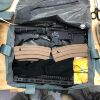https://www.popularmechanics.com/military/weapons/a30987343/gau-5a-assault-rifle/
Interesting evolution of the bailout rifle.


Interesting evolution of the bailout rifle.




Used only in certain theaters.
I've known a couple guys who earned the "Martin Baker Fan Club" patches for their flight jackets. Anyway, I'm sure Scott O'Grady would've felt a little better with the rifle and four mags than just the M9 he had at the time (I had a great weekend at Piancavallo ruined when he got shot down, had to return to my unit and get ready to help look for him, which didn't end up happening).Made me think of a buddy who worked in the seat shop. "Meet your maker in a Martin Baker!"
I guess I don’t know much about ejection seats. The seat separates from the pilot after ejection, so how does the gun stay with the pilot?
That whole deal was shady as f*** by the government. They put out a request for proposal (fedbizopps) for that rifle like two years ago. A bunch of different AR makers bid on the contract and sent in the requisite sample rifles. The government played with the samples got all the good ideas and then sent the samples back and did not award the contract to anyone. They just built them in house steeling the best ideas from the various submission guns. Very shady...
Just as coloration to this - the FAR pretty much states that bid costs are recoverable if the RFP is not awarded. So, it's not like the bidders somehow lost IP or money in responding to the RFP - they just lost the ability to make money by federating COTS gear into a new weapon.So the RFP (that they paid for) showed them that there wasn't anything out there substantially better than what they could easily organically assemble from COTs parts, and you're saying it's shady that they put the commerical parts together in house instead of paying a contractor a big markup to put the parts together for them across the street?
I'm Joe Taxpayer, and I endorse this method!The government played with the samples got all the good ideas and then sent the samples back and did not award the contract to anyone. They just built them in house steeling the best ideas from the various submission guns.
The kit hangs below the pilot from a lanyard when he separates from the seat. Here's some info on the ACES II, a seat in common use in the AF.
http://www.ejectionsite.com/a10aces.htm
?
I'm Joe Taxpayer, and I endorse this method!
For once, we're not buying a solid gold toilet seat from some Senator's district. . .
Except they were stealing IP and not paying for it.
I've probably proposed several billion dollars worth of weapons system work to the government over the last forty (40) years. In every case, the contents of the proposal were delivered as company proprietary data under some form of limited data rights, meaning that the .gov could not share it with my competitors but had ownership of the data within the context of the RFP. No theft of IP is needed if the IP is incorporated into the proposal and delivered under data rights that allow the .gov to assert some ownership of the contents of the proposal. The CFR makes it very clear that the .gov can assert ownership of IP contained in a proposal :Except they were stealing IP and not paying for it.
(e) Information available without restrictions. The Government's rights to use, modify, reproduce, release, perform, display, or, disclose information contained in a bid or proposal, including technical data or computer software, and to permit others to do so, shall not be restricted in any manner if such information has been released or disclosed to the Government or to other persons without restrictions other than a release or disclosure resulting from the sale, transfer, or other assignment of interest in the information to another party or the sale or transfer of some or all of a business entity or its assets to another party.
And there ya have it.Nope the only people with protected IP were the companies who designed the actual commercial parts, and the .gov bought the parts from them. How to put together an AR from COTs parts is not protected IP and the specific packing cube requirements governing barrel length, etc came from the AF. The offeror had nothing of value to sell except other people's ideas, therefore the AF bought from those other people, not the Offeror. Perfectly legal and logical, there's a reason you didn't see a successful protest or lawsuit.
I prefer the Luftwaffe's idea of an 'Egress survival weapon' (Imagine how long that word would be in German!)
A Sauer Drilling.
I've probably proposed several billion dollars worth of weapons system work to the government over the last forty (40) years. In every case, the contents of the proposal were delivered as company proprietary data under some form of limited data rights, meaning that the .gov could not share it with my competitors but had ownership of the data within the context of the RFP. No theft of IP is needed if the IP is incorporated into the proposal and delivered under data rights that allow the .gov to assert some ownership of the contents of the proposal. The CFR makes it very clear that the .gov can assert ownership of IP contained in a proposal :
https://www.law.cornell.edu/cfr/text/48/252.227-7016
This is no different than an RFI : the .gov goes fishing for ideas to solve an unmet requirement, and if they get enough responses they either move to a 'buy' or they move to develop the capability. That development activity can be solicited from either a .gov lab, an FFRDC, or industry (via Sole Source J&A or competitive RFP).
And there ya have it.
